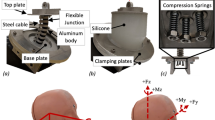Abstract
By forcing the torso of a subject to move in a fore and aft direction, in a sinusoidal manner at various frequencies, the response of the head-neck system to an external force has been established. The duration of a typical pulse of force, as encountered in boxing, was measured, and hence it was inferred that in this situation the head is mass-controlled; i.e. the effect of the rigidity and damping of the neck is negligible. The magnitude of the force pulses has been measured at the lower level of their range in a concurrent experiment on a human head and a dynamically equivalent dummy, and by extrapolation estimated for higher levels for the head. The duration and magnitude of the estimated pulse were used in conjunction with the Gadd Severity Index—developed for road safety—and it was found that in a realistic boxing situation a ‘safe level’ can be exceeded by a factor of 4.
Sommaire
On a déterminé la réaction du système tête-cou à une force extérieure en forçant le torse d'un sujet à se mouvoir d'avant en arrière, selon un tracé sinusoïdal, à diverses fréquences. La durée d'une impulsion de force caractéristique, telle que rencontrée dans la boxe, a été mesurée, et, de là, on a déduit que la tête est commandée par la masse, c'est-à-dire que l'effet de la rigidité et de l'amortissement du cou est négligeable. L'amplitude des impulsions de force a été mesurée au niveau inférieur de leur gamme dans une expérience effectuée simultanément sur une tête humaine et un modèle dynamiquement équivalent, et évaluée par extrapolation pour des niveaux plus élevés pour la tête. La durée et l'amplitude des impulsions évaluées ont été utilisées conjointement avec l'indice de gravité de Gaad—mis au point pour la sécurité routière—et on a constaté que dans une situation de boxe correspondant à la réalité, un ‘niveau de sécurité’ peut être dépassé par un facteur de quatre.
Zusammenfassung
Die Reaktion von Kopf und Nacken auf eine von außen angewandte Kraft wurde festgestellt, indem der Torso eines Objektes zur Bewegung nach vorne und hinten bei verschiedenen Frequenzen in sinusförmiger Weise gezwungen wurde. Die Dauer einer typischen Kraftperiode, wie man sie beim Boxen antrifft, wurde gemessen. Es wurde daraus gefolgert, daß der Kopf in dieser Situation durch die Masse gesteuert wird, d.h. die Steifigkeit und Dämpfwirkung des Nackens vernachlässigbar ist. Die Stärke der Kraftperioden wurde im unteren Bereich während eines gleichzeitig stattfindenden Experiments mit einem menschlichen Kopf und einer dynamisch gleichwertigen Attrappe durchgeführt und beim Kopf durch Extrapolation für den höheren Bereich geschätzt. Dauer und Stärke der geschätzten Perioden wurden in Verbindung mit dem Stärkeindex von Gadd geschätzt—der für die Verkehrssicherheit entwickelt wurde—und es wurde festgestellt, daß die ‘sichere Grenze’ beim eigentlichen Boxen um das 4-fache überstiegen werden kann.
Similar content being viewed by others
References
Bass, A. L., Blonstein, J. L., James, R. D. andWilliams, J. G. P. (1965) In:Medical aspects of boxing. Pergamon Press, Oxford.
Corsellis, A. N., Brutton, C. J. andFreeman-Brown, D. (1973) The aftermath of boxing.Psychological Med. 3, 270.
Denny-Brown, D. andRussell, N. R. (1941) Experimental cerebral concussion,Brain 64, 93–164.
Gadd, C. W. (1962)Criteria for injury protection. National Academy of Sciences. National Research Council Publication No. 977.
Gurdjian, E. S., Lange, W. A., Patrick, L. M. andThomas, L. M. (1970) In:Impact injury and crash protection. Thomas. Springfield, Ill.
Gurdjian, E. S., Webster, J. E. andLissner, H. R. (1955) Observations on the mechanism of brain concussion, contusion and laceration.Surgery, Gynaecology and Obstetrics,101.
Jokl, E. (1941) In:The medical aspect of boxing. J. L. Van Schaik, Pretoria.
Ommaya, A. K. (1966) In:Experimental head injury in the monkey. Proc. Head Injury Conference. Eds.W. F. Caveness andA. F. Walker, J. B. Lippincott Co.
Royal Coll. of Physicians (1969)Report on medical aspects of boxing.
Unterharnscheidt, F. andSellier, K. (1970) Vom Boxen, Mechanik, Pathologie und Klinik der traumatischen Schaden des XNS bei Boxern.Med. u. Sport. 10.
Author information
Authors and Affiliations
Rights and permissions
About this article
Cite this article
Johnson, J., Skorecki, J. & Wells, R.P. Peak accelerations of the head experienced in boxing. Med. & biol. Engng. 13, 396–404 (1975). https://doi.org/10.1007/BF02477111
Received:
Accepted:
Issue Date:
DOI: https://doi.org/10.1007/BF02477111




